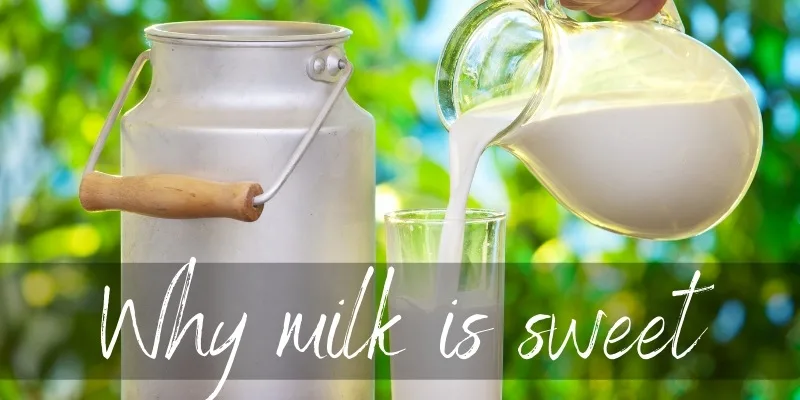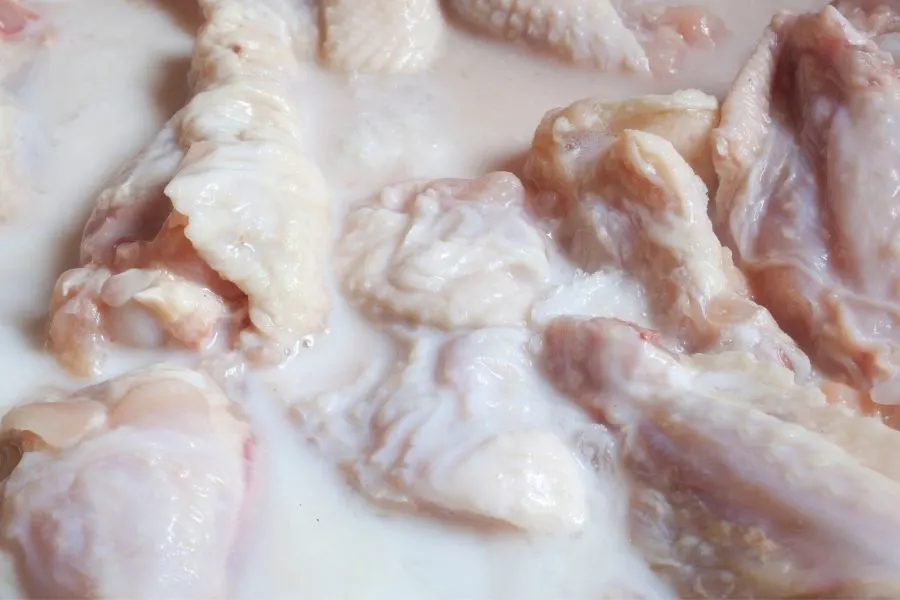Isn’t milk amazing ? Well we’re sure it’s not, if you’re lactose intolerant. But if you don’t have such trouble then milk is one of the most delectable things you can ever eat or drink.
It’s creamy, it’s rich, it’s sweet, it goes with lots of things, it’s amazing in cereal, and is a staple in most houses. But what’s this about milk being sweet ?
Why is milk sweet, and can everyone taste it ? Well, today we’re going to talk about exactly that, and how you can take advantage of milk’s sweetness.

Why is milk sweet ?
Milk is sweet because it contains lactose, which is a type of sugar. Once lactose enters our bodies, it’s broken down into glucose (simple sugar) and galactose (also simple sugar).
These two sugars are naturally present in milk. Lactose makes up anywhere between 2 and 8% of milk’s total volume, depending on the milk type. Cow’s milk tends to be the sweetest, with 12 grams of lactose per 250 ml.
Another reason milk is sweet is that the natural sugars interact with the natural fats in milk. Like with donuts, fries, and bacon, fats amplify flavors and manage to make sweet foods seem even sweeter.
It’s true that milk is sweet objectively, but it may not appear to be that sweet for everyone.
Read Also:Milk Boil Temperature
Why doesn’t milk taste sweet for me ?
The main reason milk doesn’t taste sweet to some folks is because our bodies get used to whatever level of sugar we feed it. Means the sugars in bread, ketchup, mayo, sweet potatoes, a sauce for roast beef, actual sweets and chocolate, and how much sugar we take in our coffee all play a role.
If we get used to even medium amounts of sugar, our bodies will mostly ignore the sugar in milk and only detect the fat and salt content. This leads many people to claim that milk is more of a savory solution.
While it’s true that milk does contain some natural salt (about 44 milligrams/100 ml), it contains way more sugar (about 5 grams per 100 ml).
What you can do to be able to taste sweetness in milk is to reduce your overall sugar intake. Your body will get used to less and you will notice the slight sweetness of the milk.
An added bonus is that you will also notice other flavors as well. Sugar and salt are flavor enhancers, and when you cut them down you start to notice other notes like smoky, nutty, buttery, meaty, fresh and so many more in your foods.
Why is milk sweeter when heated ?
Milk is sweeter when heated because lactose breaks down faster when it’s exposed to heat. Means that instead of breaking down in our bodies into those two sugars, it starts breaking down in the cup.

This makes our taste buds taste more sugar, leading to a sweeter taste. There is also the fact that milk just smells amazing when warm, and smell is linked to taste.
If we like the way it smells, we like the way it tastes and vice versa. So we’ll be inclined to think milk tastes sweeter hot just by smelling it.
Ways to use milk’s sweetness
All that being said, there’s lots of ways to take advantage of the way milk tricks our brains. Either to enhance some flavors or mute others, milk can be used to our advantage.
Note that there are more options than we list here, these are just the most obvious ones we could think of. They all rely on milk’s sugar and fat content.
Only add milk or cream to coffee
If you’re looking to cut down on sugar you can start by switching it to pure milk. We recommend whole milk in this case, or those little creamers.
This works because the fats and lactose in milk will take the edge off coffee. Milk reduces bitterness and adds creaminess to a cup of coffee, making it a more enjoyable experience (unless you take it black).
It also works as an amazing exercise if you’re working your way down to black coffee, all the way from a sweet latte. The sugar is the first to go, because the milk helps much more.
Survive on coffee with just milk and you’re good to go.
Add milk to mashed potatoes
Due to milk’s fat content your mashed potatoes will turn out even more delicious. You’re adding fat and protein and a hint of sweetness through all that milk.
Read also: Can You Make Instant Mashed Potatoes Without Milk ?
True, you don’t need to add a lot of milk and adding some butter will work wonders too. But we recommend you drain the potatoes completely and only add milk as the liquid, along with butter.
You’ll thank us and get the most amazing batch of mashed potatoes you’ve ever had !
Marinate chicken in milk
It may sound weird but marinating chicken in milk and spices helps give it an even more tender, juicy feel. That sweetness and fat from the milk will really make all the flavors stick to the meat.

Not only that but the lactic acid will help break down the protein in meat, making it more tender. Be sure to cook the milk from the marinade into a sauce !
Another option is to use yoghurt for a marinade, as it has even more lactic acid than milk. For those who don’t know, lactic acid is produced by bacteria that eat up the lactose in milk.
Add a splash of milk to an omelet
If you like your omelets to be fluffy and soft and possibly juicy, then consider adding a little bit of milk. You only need a couple of tablespoons per egg, otherwise the mixture gets too runny.
The milk makes the dish more delicious and simply elevated the flavor. Again, don’t use too much milk or it will just curdle in the pan.
Use some milk in curry to tone down the spices
If you’re a fan of curry but find the spices too strong, and don’t want to add fewer spices then consider using some milk instead of water. Even if you use half milk and half water, the spices will be milder.
Use only milk to get a very milk yet aromatic curry. By mild we mean there won’t be a spicy kick, while still preserving most of the flavor in the curry.
It’s a well known fact that milk helps reduce spiciness, so if you ever find something too hot for you, reach for the milk.

